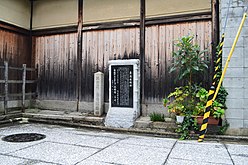Kōrokan
This article needs additional citations for verification. (September 2022) |
筑紫の鴻臚館 | |
 Fukuoka Kōrokan Museum | |
| Location | Hakata-ku, Fukuoka, Japan |
|---|---|
| Region | Kyushu |
| Coordinates | 33°35′09″N 130°23′09″E / 33.58583°N 130.38583°E |
| History | |
| Periods | Nara - Heian period |
| Site notes | |
 | |
The kōrokan (鴻臚館, こうろかん) were guest houses for foreign ambassadors, traveling monks, and merchants that existed in Japan from the Asuka period to the end of the Heian period. These guest houses existed in Fukuoka, Osaka and Kyoto. The word kōrokan (鴻臚館) was coined in the Heian period by using the first two characters from the Chinese name 鴻臚寺 for Han dynasty and Qi dynasty temples charged with the responsibility of hosting foreign dignitaries.[1] Only the location of the kōrokan in Fukuoka is known with precision today; its ruins were discovered on the grounds of Maizuru Castle Park in 1987 and were designated a National Historic Site in 2004.[2] The guest house in Fukuoka is called Tsukushi Kōrokan (筑紫の鴻臚館), after the name of Tsukushi Province, which is part of Fukuoka Prefecture today
Tsukushi Kōrokan
After the
The name "Kōrokan" appears for the first time in 837 in the[[
Initially, trade at Kōrokan was government-run. Dazaifu was notified of the arrival of the merchant ship, and a courier was sent from Dazaifu to the Imperial Court. Officials called Karamonozukai were then dispatched from the
During the
Wooden tablets and tiles were unearthed during excavations. Other unearthed items include Shaoxing kiln celadon, Changsha kiln porcelain, Jingzhou kiln white porcelain, pottery from Silla and Goryeo, blue-glazed pottery from the Islamic world, and Persian glass. It was also revealed that the buildings were divided into five periods over time. However, the remains of the 4th period from the late 9th century and the 5th period from the late 10th century to the early 11th century were destroyed by the construction of Fukuoka Castle. Analysis of parasite eggs in the remains of toilets from the Nara period revealed that the toilets of foreigners who regularly ate pigs and wild boars and the Japanese people had separate toilets. Furthermore, it has been revealed that the toilets were separated by gender, and that sticks called chuugi were used for toilet paper.
In 1995, the Kōrokan Ruins Exhibition Hall was built on the south side of the ruins after the excavation survey was completed, and the discovered ruins and excavated artifacts are on display. In the spring of 2016, the remains were backfilled and opened to the public as a lawn plaza. There is a mark indicating the site of the building.[4]
The site is a 10 minute walk from Akasaka Station on the Fukuoka City Subway Airport Line.[4]
-
Tsukushi Kōrokan ruins
-
Tsukushi Kōrokan partial reconstruction
Naniwa Kōrokan (Osaka)
The Osaka kōrokan was located in Namba-tsu (Watanabe-tsu), the ancient port of the Yamato Kingdom since the
Heian-kyō Kōrokan (Kyoto)
When the imperial capital moved to
-
Tōkōrokan (east guest house) Monument
-
Nishikōrokan (west guest house) Explanation Board
The Heian-kyo kōrokan is mentioned in the first chapter of The Tale of Genji. The novel's protagonist, Hikaru Genji, was sent when he was a seven years old to see an expert physiognomist from Goryeo staying at the kōrokan. The physiognomist sees signs that Hikaru is destined to achieve a "sovereign's supreme eminence".[7]
A monument erected in 1915 marks the site of Higashi Kōrokan in Nishishinyashiki Ageya-cho, Shimogyo-ku.
See also
References
- ^ Des Rotours, Robert (1947). Traite des Fonctionnaires et Traite de l'Armee. Traduits de la Nouvelle Histoire des T'ang. E. J. Brill. pp. 408–417.
- ^ "鴻臚館跡附女原瓦窯跡" (in Japanese). Agency for Cultural Affairs. Retrieved December 20, 2023.
- ^ {{cite wikisource |title=Nihongi: Chronicles of Japan from the Earliest Times to A.D. 697:Book XXX |wslink=Nihongi:_Chronicles_of_Japan_from_the_Earliest_Times_to_A.D._697/Book_XXX}
- ^ ISBN 4311750404.(in Japanese)
- ISBN 978-1-62138-651-3.
- ^ – via Wikisource.
- ISBN 978-0-14-243714-8.
External links
![]() Media related to Kourokan at Wikimedia Commons
Media related to Kourokan at Wikimedia Commons
- Korokan Ruins Museum
- Fukuoka City Guide: Korokan Historical Museum
- Cultural Properties in Fukuoka(in Japanese)
- Fukuoka Tourism Web(in Japanese)






